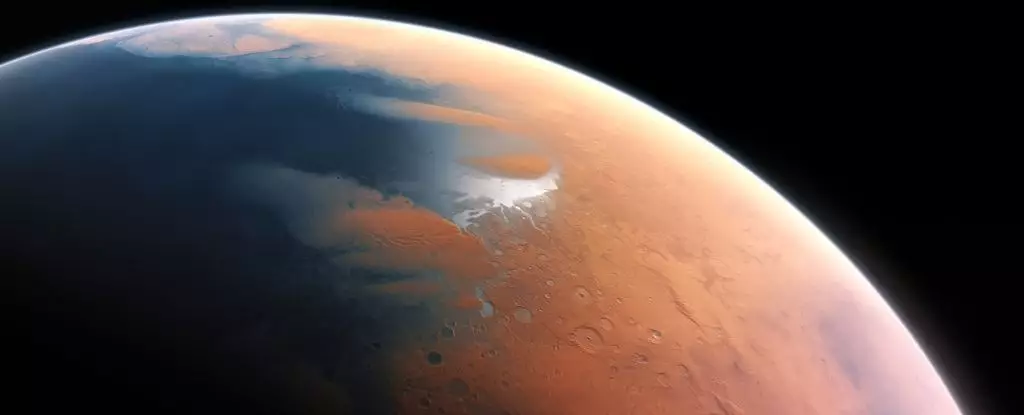Mars has long captivated the imagination of scientists, enthusiasts, and the general public alike. Its rich geological history, once teeming with potential for life, now stands as a barren reminder of transformation. Yet, recent investigations suggest that salvation may lie beneath its dusty, red plains. Emerging evidence points to the presence of vast reservoirs of liquid water buried deep within the Martian crust, a discovery that could reshape not only our understanding of Mars but also pave the way for potential human exploration in the future.
For decades, the cessation of water flow on Mars has puzzled researchers. Ancient river valleys and lake beds mark a landscape that was once lush with life. However, the climax of this aquatic narrative has eluded explanation. Recent seismic analysis conducted by NASA’s InSight mission managed to uncover a tantalizing detail: as seismic waves traverse the Martian crust, they slow down in a specific layer located approximately 5.4 to 8 kilometers below the surface. This anomaly raises the possibility that liquid water is held within those depths, merging past geological wisdom with new technological advancements.
The Ancient Oceans and Their Fate
Understanding the fate of Mars’ ancient bodies of water requires a consideration of several catastrophic events. During the Noachian and Hesperian periods—spanning 4.1 to 3 billion years ago—the Martian surface was rich with rivers and lakes. As the planet’s magnetic field deteriorated and atmospheric pressure diminished, these water sources disappeared, succumbing to forces of evaporation, escaping into space, freezing into polar caps, or becoming enshrined in various minerals. Yet even this multifaceted loss of water does not completely account for estimates suggesting that the “missing” water could cover the planet to depths of 700 to 900 meters.
One compelling hypothesis suggests that the missing water may have percolated into the Martian crust through fractures created by meteorite impacts during the tumultuous Noachian period. These geological wounds could have served as conduits for water to seep underground, where higher temperatures would sustain it in a liquid state, contrary to the freezing conditions closer to the surface.
The Seismic Symphony of Mars
The InSight lander, which gracefully touched down on Mars in 2018, has been instrumental in unveiling the secrets lying in the planet’s crust. By employing a meticulously sensitive seismometer, scientists studied shear waves—vibrations that travel through the crust and reflect its structural mystery. The discovery of a low-velocity layer suggests a highly porous rock formation, akin to Earth’s aquifers, saturated with liquid water. This revolutionary find indicates the potential for water reserves that could blanket the planet in oceans ranging from 520 to 780 meters deep—far exceeding even the vast reserves locked away in Earth’s Antarctic ice sheet.
To reach this conclusion, the research team meticulously analyzed data from seismic events linked to meteorite impacts in 2021 alongside the detection of marsquakes in 2022. They harnessed high-frequency vibrations to produce what can be likened to a geological X-ray, mapping hidden water reservoirs that take us deeper into understanding Mars’ past and present.
Life and Sustainability: The Ripple Effects of Water Discovery
The implications of finding liquid water on Mars stretch far beyond academic curiosity; they carry significant weight for the future of human exploration. In Earth’s systems, liquid water is fundamental to life as we know it, and the possibility of microbes or even remnants of ancient ecosystems surviving in Martian aquifers ignites a spark of hope. Furthermore, in the context of prolonged human colonization, this subsurface water could provide essential resources—purified water, oxygen, and even fuel for interplanetary travel.
Nonetheless, the endeavor of drilling deep beneath the Martian landscape poses considerable challenges, including the risk of contamination from Earthly microbes, which could obliterate any native biological entities that might exist.
Mapping the Martian Pattern
As exciting as these findings are, they represent only the tip of the iceberg. The current seismic data from the InSight mission only scratches the surface of what lies beneath Mars. Future missions equipped with advanced seismometers are crucial to fully understand the potential extent of these water-rich zones and uncover other hidden resources scattered across the Martian terrain. Speculation suggests that areas like Utopia Planitia may harbor additional aquifers waiting to be explored.
In this age of discovery, Mars beckons to humanity, whispering secrets of a bygone era and possibilities for the future. While we continue to listen to the seismic heartbeat of this enigmatic planet, there lies a promise not just of discovery but of survival, evolution, and perhaps a new home in the cosmos.

